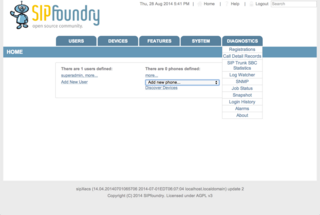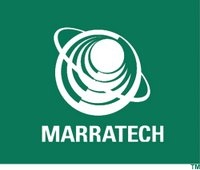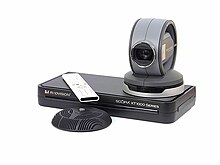
Tandberg was an electronics manufacturer located in Oslo, Norway and New York City, United States. The company began in the radio field, but became more widely known for their reel-to-reel tape recorders as well as cassette decks and televisions. The original company went bankrupt in 1978, after a sharp financial downturn. The following year, the company re-formed whilst their data division was split off as Tandberg Data, including the tape recording division, which reduced its scope to data recording.
Mitel Networks Corporation is a Canadian telecommunications company. The company previously produced TDM PBX systems and applications, but after a change in ownership in 2001, now focuses almost entirely on Voice-over-IP (VoIP), unified communications, collaboration and contact center products. Mitel is headquartered in Ottawa, Ontario, Canada, with offices, partners and resellers worldwide.

Digium, Inc. is a communications technology company based in Huntsville, Alabama, and since 2018, a subsidiary of Sangoma Technologies Corporation. The company makes VoIP business phone systems, IP phones, and hardware products. It was founded in 1999 by Mark Spencer.
CU-SeeMe is an Internet videoconferencing client. CU-SeeMe can make point to point video calls without a server or make multi-point calls through server software first called a "reflector" and later called a "conference server" or Multipoint Control Unit (MCU). Later commercial versions of CU-SeeMe could also make point-to-point or multi-point calls to other vendor's standard H.323 endpoints and servers.

Skype for Business Server is real-time communications server software that provides the infrastructure for enterprise instant messaging, presence, VoIP, ad hoc and structured conferences and PSTN connectivity through a third-party gateway or SIP trunk. These features are available within an organization, between organizations and with external users on the public internet or standard phones.

SipXecs is a free software enterprise communications system. It was initially developed by Pingtel Corporation in 2003 as a voice over IP telephony server located in Boston, MA. The server was later extended with additional collaboration capabilities as part of the SIPfoundry project. Since its extension, sipXecs now acts as a software implementation of the Session Initiation Protocol (SIP), making it a full IP-based communications system.
net2phone is a Cloud Communications provider offering cloud based telephony services to businesses worldwide. The company is a subsidiary of IDT Corporation.

Marratech was a Swedish company that made software for e-meetings. It was acquired by Google in 2007.
Spirent Communications plc is a British multinational telecommunications testing company headquartered in Crawley, West Sussex, in the United Kingdom. It is listed on the London Stock Exchange and is a constituent of the FTSE 250 Index.

Sierra Wireless is a Canadian multinational wireless communications equipment designer, manufacturer and services provider headquartered in Richmond, British Columbia, Canada. It also maintains offices and operations in the United States, Korea, Japan, Taiwan, India, France, Australia and New Zealand.

Scopia, within the computer networking and telecommunications fields, is a series of unified communications products that provide meet-me, videoconferencing and online collaboration. The Scopia products include the Scopia XT Telepresence, Scopia XT7100 Room System, Scopia XT5000 Room System, Scopia XT4300 Room System, SCOPIA XT1000 Piccolo,XT Meeting Center Room System, Scopia Firewall Traversal, Multipoint control units, Gateways, Scopia Control, Scopia Desktop Video Conferencing, and Scopia Mobile HD Video Conferencing. The Scopia products are developed and sold by Avaya and their Business Partner network.
Unified communications (UC) is a business and marketing concept describing the integration of enterprise communication services such as instant messaging (chat), presence information, voice, mobility features, audio, web & video conferencing, fixed-mobile convergence (FMC), desktop sharing, data sharing, call control and speech recognition with non-real-time communication services such as unified messaging. UC is not necessarily a single product, but a set of products that provides a consistent unified user interface and user experience across multiple devices and media types.
The Innovative Communications Alliance (ICA) was a telecommunications alliance between Microsoft and Nortel, created in July 2006, to co-develop, integrate, market, sell, and support unified communications products. The goal of the alliance is to make integrated hardware and software solutions that join together voice, video, and data communications without requiring gateways or middleware. Microsoft and Nortel share developing technologies and patents for unified communications products.
RingCentral, Inc. is an American provider of cloud-based communication and collaboration products and services.
Voxeo Corporation was a technology company that specialized in providing development platforms for unified customer experience (self-service) and unified communications applications. Voxeo was headquartered in Orlando, Florida with main offices in Cologne, Germany; Beijing, China; London, UK and San Francisco, US.
The Unified Communications Interoperability Forum (UCIF) is a non-profit alliance between communications technology vendors. It was announced on May 19, 2010, with the vision to maximize the interoperability of UC based on existing standards. Founding members of UCIF were HP, Microsoft, Polycom, Logitech / LifeSize Communications, and Juniper Networks. On July 28, 2014, UCIF merged with International Multimedia Telecommunications Consortium (UMTC) into one consortium.

Avaya 9600-series IP deskphones are 15 different desk handset devices that are used for unified communications. The phones are compatible with the Avaya Aura platform of products and IP office systems. The systems add high-quality voice codecs like the G.722 codec and new menus over older IP phone series. The 9620 includes 16 MB of flash memory and the 9630 includes 32 MB of flash memory.

Boaz Raviv, born on April 1, 1961, is a French-Israeli CEO with extensive experience in the multinational technology sector. Throughout his career, he has held executive positions in various renowned companies. Notably, Raviv served as CEO at Attenti and Radvision. He also held the position of General Manager of Business Units at AVAYA, Radvision, Elron Telesoft, and made contributions as a development engineer at Capgemini. Since 2001, Raviv has actively engaged in investment, consulting, and mentoring activities, with a particular focus on high-tech companies.











